Stone Fruit Seed: A Source of Renewable Fuel for Transport
Abstract
:1. Introduction
2. Materials and Methods
2.1. Production of SFO Biodiesel and Its Blends
2.2. Engine Setup and Experimental Procedure
2.3. Error and Uncertainty
3. Results and Discussion
3.1. Characterisation Properties and Fatty Acid Composition of SFO Biodiesel and Its Blends
3.2. Engine Performance
3.3. Emission Characteristics
3.4. Combustion Behaviour
4. Conclusions
- The analysis of the physicochemical properties of SFO biodiesel revealed that it fulfilled all international standards (ASTM D6751-2, EN 14214 and Australian biodiesel standard). The chromatogram of SFO biodiesel confirmed the formation of methyl esters. The fatty acid compositional analysis of SFO biodiesel indicates a high level (89.7%) of unsaturated fatty acids with high oleic acid content (63.8%).
- The average BP reductions for SFO5, SFO10 and SFO20 relative to diesel were 2.3%, 3.4% and 4.67%, respectively, which are attributed to higher biodiesel blends with lower calorific values, higher viscosities and higher densities. The average decreases in torque values for SFO5, SFO10 and SFO20 relative to diesel were 1.17%, 2.26% and 3.54%, respectively. The average increases in BSFC values for SFO5, SFO10 and SFO20 compared to diesel were 4.73%, 7.63% and 15.4%, respectively. Diesel had the highest BTE of all engine speeds followed by SFO5, SFO10 and SFO20.
- The average increases in EGT values for SFO5, SFO10 and SFO20 were 0.87%, 3.56% and 6.16%, respectively, relative to diesel. The NOx and CO2 emissions were increased, whereas the CO and HC emissions were decreased, with the increase in the biodiesel percentage in the fuel blends. Due to lower volatility and higher oxygen content, the PM emissions were also decreased and the average decreases were 23.43%, 26.43% and 32.62%, respectively, for SFO5, SFO10 and SFO20 relative to diesel.
- The SFO20 biodiesel blend had the highest cylinder pressure among the fuels tested. Combustion delay time for SFO20 fuel was less than that for other fuels, whereas diesel had the longest combustion delay. It was evident that, as the concentration of biodiesel increased, the duration of combustion also increased. The results revealed that SFO20 produced the highest in-cylinder temperature due to its highest HRR. These results also demonstrated that the highest MFB was related to SFO20.
Author Contributions
Funding
Institutional Review Board Statement
Informed Consent Statement
Acknowledgments
Conflicts of Interest
References
- BP Energy Outlook 2040. Available online: https://www.bp.com/content/dam/bp/business-sites/en/global/corporate/pdfs/energy-economics/energy-outlook/bp-energy-outlook-2019.pdf (accessed on 1 May 2019).
- Demirbas, A. Progress and recent trends in biofuels. Prog. Energy Combust. Sci. 2007, 33, 1–18. [Google Scholar] [CrossRef]
- Zabed, H.M.; Akter, S.; Yun, J.; Zhang, G.; Awad, F.N.; Qi, X.; Sahu, J.N. Recent advances in biological pretreatment of microalgae and lignocellulosic biomass for biofuel production. Renew. Sustain. Energy Rev. 2019, 105, 105–128. [Google Scholar] [CrossRef]
- Abdullah, B.; Syed Muhammad, S.A.F.a.; Shokravi, Z.; Ismail, S.; Kassim, K.A.; Mahmood, A.N.; Aziz, M.M.A. Fourth generation biofuel: A review on risks and mitigation strategies. Renew. Sustain. Energy Rev. 2019, 107, 37–50. [Google Scholar] [CrossRef]
- Jahirul, M.I.; Rasul, M.G.; Chowdhury, A.A.; Ashwath, N. Biofuels Production through Biomass Pyrolysis—A Technological Review. Energies 2012, 5, 4952–5001. [Google Scholar] [CrossRef]
- Bhuiya, M.M.K.; Rasul, M.G.; Khan, M.M.K.; Ashwath, N.; Azad, A.K. Prospects of 2nd generation biodiesel as a sustainable fuel—Part: 1 selection of feedstocks, oil extraction techniques and conversion technologies. Renew. Sustain. Energy Rev. 2016, 55, 1109–1128. [Google Scholar] [CrossRef]
- Anwar, M.; Rasul, M.G.; Ashwath, N. Production optimization and quality assessment of papaya (Carica papaya) biodiesel with response surface methodology. Energy Convers. Manag. 2018, 156, 103–112. [Google Scholar] [CrossRef]
- Li, J.; Chen, X.; Yi, Z.; Yang, H.; Tang, Y.; Yi, Y.; Yao, W.; Wang, J.; Yi, Y. Broadband solar energy absorber based on monolayer molybdenum disulfide using tungsten elliptical arrays. Mater. Today Energy 2020, 16, 100390. [Google Scholar] [CrossRef]
- Zhang, J.; Wang, H.; Yuan, X.; Zeng, G.; Tu, W.; Wang, S. Tailored indium sulfide-based materials for solar-energy conversion and utilization. J. Photochem. Photobiol. C Photochem. Rev. 2019, 38, 1–26. [Google Scholar] [CrossRef]
- Alva, G.; Liu, L.; Huang, X.; Fang, G. Thermal energy storage materials and systems for solar energy applications. Renew. Sustain. Energy Rev. 2017, 68, 693–706. [Google Scholar] [CrossRef]
- Marugán, A.P.; Márquez, F.P.G.; Perez, J.M.P.; Ruiz-Hernández, D. A survey of artificial neural network in wind energy systems. Appl. Energy 2018, 228, 1822–1836. [Google Scholar] [CrossRef] [Green Version]
- Tascikaraoglu, A.; Uzunoglu, M. A review of combined approaches for prediction of short-term wind speed and power. Renew. Sustain. Energy Rev. 2014, 34, 243–254. [Google Scholar] [CrossRef]
- Abe, J.O.; Popoola, A.P.I.; Ajenifuja, E.; Popoola, O.M. Hydrogen energy, economy and storage: Review and recommendation. Int. J. Hydrogen Energy 2019, 44, 15072–15086. [Google Scholar] [CrossRef]
- Parra, D.; Valverde, L.; Pino, F.J.; Patel, M.K. A review on the role, cost and value of hydrogen energy systems for deep decarbonisation. Renew. Sustain. Energy Rev. 2019, 101, 279–294. [Google Scholar] [CrossRef]
- Singh, D.; Sharma, D.; Soni, S.L.; Sharma, S.; Kumar Sharma, P.; Jhalani, A. A review on feedstocks, production processes, and yield for different generations of biodiesel. Fuel 2020, 262, 116553. [Google Scholar] [CrossRef]
- Jahirul, M.I.; Koh, W.; Brown, R.J.; Senadeera, W.; O’Hara, I.; Moghaddam, L. Biodiesel production from non-edible beauty leaf (Calophyllum inophyllum) oil: Process optimization using response surface methodology (RSM). Energies 2014, 7, 5317–5331. [Google Scholar] [CrossRef] [Green Version]
- Haseeb, A.S.M.A.; Fazal, M.A.; Jahirul, M.I.; Masjuki, H.H. Compatibility of automotive materials in biodiesel: A review. Fuel 2011, 90, 922–931. [Google Scholar] [CrossRef]
- Rahman, M.M.; Pourkhesalian, A.M.; Jahirul, M.I.; Stevanovic, S.; Pham, P.X.; Wang, H.; Masri, A.R.; Brown, R.J.; Ristovski, Z.D. Particle emissions from biodiesels with different physical properties and chemical composition. Fuel 2014, 134, 201–208. [Google Scholar] [CrossRef]
- Shi, W.; Li, J.; He, B.; Yan, F.; Cui, Z.; Wu, K.; Lin, L.; Qian, X.; Cheng, Y. Biodiesel production from waste chicken fat with low free fatty acids by an integrated catalytic process of composite membrane and sodium methoxide. Bioresour. Technol. 2013, 139, 316–322. [Google Scholar] [CrossRef]
- Hoekman, S.K.; Broch, A.; Robbins, C.; Ceniceros, E.; Natarajan, M. Review of biodiesel composition, properties, and specifications. Renew. Sustain. Energy Rev. 2012, 16, 143–169. [Google Scholar] [CrossRef]
- Jahirul, M.I.; Brown, R.J.; Senadeera, W.; O’Hara, I.M.; Ristovski, Z.D. The use of artificial neural networks for identifying sustainable biodiesel feedstocks. Energies 2013, 6, 3764–3806. [Google Scholar] [CrossRef] [Green Version]
- Florin, M.J.; van Ittersum, M.K.; van de Ven, G.W.J. Selecting the sharpest tools to explore the food-feed-fuel debate: Sustainability assessment of family farmers producing food, feed and fuel in Brazil. Ecol. Indic. 2012, 20, 108–120. [Google Scholar] [CrossRef]
- Babazadeh, R.; Razmi, J.; Pishvaee, M.S.; Rabbani, M. A sustainable second-generation biodiesel supply chain network design problem under risk. Omega 2017, 66, 258–277. [Google Scholar] [CrossRef] [Green Version]
- Bhuiya, M.M.K.; Rasul, M.G.; Khan, M.M.K.; Ashwath, N.; Azad, A.K.; Hazrat, M.A. Second Generation Biodiesel: Potential Alternative to-edible Oil-derived Biodiesel. Energy Procedia 2014, 61, 1969–1972. [Google Scholar] [CrossRef] [Green Version]
- Anwar, M.; Rasul, M.G.; Ashwath, N. The efficacy of multiple-criteria design matrix for biodiesel feedstock selection. Energy Convers. Manag. 2019, 198, 111790. [Google Scholar] [CrossRef]
- Sharma, R.; Gupta, A.; Abrol, G.S.; Joshi, V.K. Value addition of wild apricot fruits grown in north-west himalayan regions: A review. J. Food Sci. Technol. 2012, 51, 2917–2924. [Google Scholar] [CrossRef] [PubMed] [Green Version]
- Kate, A.E.; Lohani, U.C.; Pandey, J.P.; Shahi, N.C.; Sarkar, A. Traditional and mechanical method of the oil extraction from wild apricot kernel: A comparative study. Res. J. Chem. Environ. Sci. 2014, 2, 54–60. [Google Scholar]
- Wang, L.; Yu, H. Biodiesel from Siberian apricot (Prunus sibirica L.) seed kernel oil. Bioresour. Technol. 2012, 112, 355–358. [Google Scholar] [CrossRef]
- Anwar, M.; Rasul, M.; Ashwath, N. Optimization of biodiesel production from stone fruit kernel oil. Energy Procedia 2019, 160, 268–276. [Google Scholar] [CrossRef]
- Singh Gurau, V.; Agarwal, M.S.; Sarin, A.; Sandhu, S.S. Experimental Study on Storage and Oxidation Stability of Bitter Apricot Kernel Oil Biodiesel. Energy Fuels 2016, 30, 8377–8385. [Google Scholar] [CrossRef]
- Gumus, M.; Kasifoglu, S. Performance and emission evaluation of a compression ignition engine using a biodiesel (apricot seed kernel oil methyl ester) and its blends with diesel fuel. Biomass Bioenergy 2010, 34, 134–139. [Google Scholar] [CrossRef]
- Hanbey, H.; Mahmut, U.Y.A.R.; Aydin, H.; Emine, Ş.A.P. The effects of apricots seed oil biodiesel with some additives on performance and emissions of a diesel engine. Int. J. Automot. Eng. Technol. 2016, 5, 2146–9067. [Google Scholar]
- Mullan Karishma, S.; Dasore, A.; Rajak, U.; Nath Verma, T.; Prahlada Rao, K.; Omprakash, B. Experimental examination of CI engine fueled with various blends of diesel-apricot oil at different engine operating conditions. Mater. Today Proc. 2021, 49, 307–310. [Google Scholar] [CrossRef]
- Holman, J.P. Experimental Methods for Engineers, 7th ed.; Tata McGraw Hill: New Delhi, India, 2004. [Google Scholar]
- Hasan, M.M.; Rahman, M.M. Performance and emission characteristics of biodiesel–diesel blend and environmental and economic impacts of biodiesel production: A review. Renew. Sustain. Energy Rev. 2017, 74, 938–948. [Google Scholar] [CrossRef] [Green Version]
- Xue, J.; Grift, T.E.; Hansen, A.C. Effect of biodiesel on engine performances and emissions. Renew. Sustain. Energy Rev. 2011, 15, 1098–1116. [Google Scholar] [CrossRef]
- Lin, B.-F.; Huang, J.-H.; Huang, D.-Y. Experimental study of the effects of vegetable oil methyl ester on DI diesel engine performance characteristics and pollutant emissions. Fuel 2009, 88, 1779–1785. [Google Scholar] [CrossRef]
- Öner, C.; Altun, Ş. Biodiesel production from inedible animal tallow and an experimental investigation of its use as alternative fuel in a direct injection diesel engine. Appl. Energy 2009, 86, 2114–2120. [Google Scholar] [CrossRef]
- Aydin, H.; Bayindir, H. Performance and emission analysis of cottonseed oil methyl ester in a diesel engine. Renew. Energy 2010, 35, 588–592. [Google Scholar] [CrossRef]
- Utlu, Z.; Koçak, M.S. The effect of biodiesel fuel obtained from waste frying oil on direct injection diesel engine performance and exhaust emissions. Renew. Energy 2008, 33, 1936–1941. [Google Scholar] [CrossRef]
- Anwar, M.; Rasul, M.; Ashwath, N.; Rahman, M. Optimisation of Second-Generation Biodiesel Production from Australian Native Stone Fruit Oil Using Response Surface Method. Energies 2018, 11, 2566. [Google Scholar] [CrossRef] [Green Version]
- Benjumea, P.; Agudelo, J.R.; Agudelo, A.F. Effect of the Degree of Unsaturation of Biodiesel Fuels on Engine Performance, Combustion Characteristics, and Emissions. Energy Fuels 2011, 25, 77–85. [Google Scholar] [CrossRef]
- Ozsezen, A.N.; Canakci, M.; Turkcan, A.; Sayin, C. Performance and combustion characteristics of a DI diesel engine fueled with waste palm oil and canola oil methyl esters. Fuel 2009, 88, 629–636. [Google Scholar] [CrossRef]
- Nabi, M.N.; Rasul, M.G.; Anwar, M.; Mullins, B.J. Energy, exergy, performance, emission and combustion characteristics of diesel engine using new series of non-edible biodiesels. Renew. Energy 2019, 140, 647–657. [Google Scholar] [CrossRef]
- Bhuiya, M.; Rasul, M.; Khan, M.; Ashwath, N. Performance and Emission Characteristics of Binary Mixture of Poppy and Waste Cooking Biodiesel. Energy Procedia 2017, 110, 523–528. [Google Scholar] [CrossRef]
- Sanjid, A.; Kalam, M.A.; Masjuki, H.H.; Varman, M.; Zulkifli, N.W.B.M.; Abedin, M.J. Performance and emission of multi-cylinder diesel engine using biodiesel blends obtained from mixed inedible feedstocks. J. Clean. Prod. 2016, 112, 4114–4122. [Google Scholar] [CrossRef]
- Rahman, M.M.; Rasul, M.G.; Hassan, N.M.S.; Azad, A.K.; Uddin, M.N. Effect of small proportion of butanol additive on the performance, emission, and combustion of Australian native first- and second-generation biodiesel in a diesel engine. Environ. Sci. Pollut. Res. Int. 2017, 24, 22402–22413. [Google Scholar] [CrossRef]
- Anwar, M.; Rasul, M.G.; Ashwath, N. A comparative study of engine performance and emission characteristics of biodiesels produced from the waste seeds of papaya and stone fruit. In Proceedings of the 2019 IEEE 2nd International Conference on Renewable Energy and Power Engineering (REPE), Toronto, ON, Canada, 2–4 November 2019. [Google Scholar]
- Anwar, M.; Rasul, M.; Ashwath, N. A Systematic Multivariate Analysis of Carica papaya Biodiesel Blends and Their Interactive Effect on Performance. Energies 2018, 11, 2931. [Google Scholar] [CrossRef] [Green Version]
- Liaquat, A.M.; Masjuki, H.H.; Kalam, M.A.; Varman, M.; Hazrat, M.A.; Shahabuddin, M.; Mofijur, M. Application of blend fuels in a diesel engine. Energy Procedia 2012, 14, 1124–1133. [Google Scholar] [CrossRef] [Green Version]
- Carraretto, C.; Macor, A.; Mirandola, A.; Stoppato, A.; Tonon, S. Biodiesel as alternative fuel: Experimental analysis and energetic evaluations. Energy 2004, 29, 2195–2211. [Google Scholar] [CrossRef]
- Ong, H.C.; Masjuki, H.H.; Mahlia, T.M.I.; Silitonga, A.S.; Chong, W.T.; Leong, K.Y. Optimization of biodiesel production and engine performance from high free fatty acid Calophyllum inophyllum oil in CI diesel engine. Energy Convers. Manag. 2014, 81, 30–40. [Google Scholar] [CrossRef]
- Mofijur, M.; Masjuki, H.H.; Kalam, M.A.; Atabani, A.E. Evaluation of biodiesel blending, engine performance and emissions characteristics of Jatropha curcas methyl ester: Malaysian perspective. Energy 2013, 55, 879–887. [Google Scholar] [CrossRef]
- Qi, D.H.; Chen, H.; Geng, L.M.; Bian, Y.Z. Experimental studies on the combustion characteristics and performance of a direct injection engine fueled with biodiesel/diesel blends. Energy Convers. Manag. 2010, 51, 2985–2992. [Google Scholar] [CrossRef]
- Anwar, M.; Rasul, M.G.; Ashwath, N. The synergistic effects of oxygenated additives on papaya biodiesel binary and ternary blends. Fuel 2019, 256, 115980. [Google Scholar] [CrossRef]
- Sajjad, H.; Masjuki, H.; Varman, M.; Kalam, M.; Arbab, M.; Imtenan, S.; Ashraful, A. Influence of gas-to-liquid (GTL) fuel in the blends of Calophyllum inophyllum biodiesel and diesel: An analysis of combustion–performance–emission characteristics. Energy Convers. Manag. 2015, 97, 42–52. [Google Scholar] [CrossRef]
- Mustayen, A.; Wang, X.; Rasul, M.; Hamilton, J.; Negnevitsky, M. Theoretical Investigation of Combustion and Performance Analysis of Diesel Engine under Low Load Conditions. In IOP Conference Series: Earth and Environmental Science; IOP Publishing: Bristol, UK, 2021. [Google Scholar]
- Anwar, M.; Rasul, M.G.; Ashwath, N. Combustion characteristics of an agricultural diesel engine fuelled with papaya and stone fruit biodiesel: A comparison. In Proceedings of the 2019 IEEE 2nd International Conference on Renewable Energy and Power Engineering (REPE), Toronto, ON, Canada, 2–4 November 2019. [Google Scholar]
- Ong, H.C.; Masjuki, H.H.; Mahlia, T.M.I.; Silitonga, A.S.; Chong, W.T.; Yusaf, T. Engine performance and emissions using Jatropha curcas, Ceiba pentandra and Calophyllum inophyllum biodiesel in a CI diesel engine. Energy 2014, 69, 427–445. [Google Scholar] [CrossRef]
- Anwar, M.; Rasul, M.G.; Ashwath, N. Investigation on the impact of papaya biodiesel-diesel blends on combustion of an agricultural CI engine. IOP Conf. Ser. Earth Environ. Sci. 2020, 463, 012001. [Google Scholar] [CrossRef]
- Devan, P.K.; Mahalakshmi, N.V. Performance, emission and combustion characteristics of poon oil and its diesel blends in a DI diesel engine. Fuel 2009, 88, 861–867. [Google Scholar] [CrossRef]
- Godiganur, S.; Suryanarayana Murthy, C.; Reddy, R.P. Performance and emission characteristics of a Kirloskar HA394 diesel engine operated on fish oil methyl esters. Renew. Energy 2010, 35, 355–359. [Google Scholar] [CrossRef]
- Anwar, M.; Rasul, M.G.; Ashwath, N. A pragmatic and critical analysis of engine emissions for biodiesel blended fuels. Fuel 2020, 270, 117513. [Google Scholar] [CrossRef]
- Mustafa, E.T.; Van Gerpen, J.H.; Wang, P.S. Fuel Property Effects on Injection Timing, Ignition Timing, and Oxides of Nitrogen Emissions from Biodiesel-Fueled Engines. Trans. ASAE 2004, 50. [Google Scholar]
- Yongcheng, H.; Longbao, Z.; Shangxue, W.; Shenghua, L. Study on the Performance and Emissions of a Compression Ignition Engine Fuelled with Fischer-Tropsch Diesel Fuel. Proc. Inst. Mech. Eng. Part D J. Automob. Eng. 2006, 220, 827–835. [Google Scholar] [CrossRef]
- Fontaras, G.; Karavalakis, G.; Kousoulidou, M.; Tzamkiozis, T.; Ntziachristos, L.; Bakeas, E.; Stournas, S.; Samaras, Z. Effects of biodiesel on passenger car fuel consumption, regulated and non-regulated pollutant emissions over legislated and real-world driving cycles. Fuel 2009, 88, 1608–1617. [Google Scholar] [CrossRef]
- Labeckas, G.; Slavinskas, S. The effect of rapeseed oil methyl ester on direct injection Diesel engine performance and exhaust emissions. Energy Convers. Manag. 2006, 47, 1954–1967. [Google Scholar] [CrossRef]
- Qi, D.H.; Geng, L.M.; Chen, H.; Bian, Y.Z.; Liu, J.; Ren, X.C. Combustion and performance evaluation of a diesel engine fueled with biodiesel produced from soybean crude oil. Renew. Energy 2009, 34, 2706–2713. [Google Scholar] [CrossRef]
- Keskin, A.; Gürü, M.; Altıparmak, D. Influence of tall oil biodiesel with Mg and Mo based fuel additives on diesel engine performance and emission. Bioresour. Technol. 2008, 99, 6434–6438. [Google Scholar] [CrossRef]
- Gürü, M.; Koca, A.; Can, Ö.; Çınar, C.; Şahin, F. Biodiesel production from waste chicken fat based sources and evaluation with Mg based additive in a diesel engine. Renew. Energy 2010, 35, 637–643. [Google Scholar] [CrossRef]
- Lin, C.-Y.; Li, R.-J. Engine performance and emission characteristics of marine fish-oil biodiesel produced from the discarded parts of marine fish. Fuel Process. Technol. 2009, 90, 883–888. [Google Scholar] [CrossRef]
- Usta, N. An experimental study on performance and exhaust emissions of a diesel engine fuelled with tobacco seed oil methyl ester. Energy Convers. Manag. 2005, 46, 2373–2386. [Google Scholar] [CrossRef]
- Koçak, M.S.; Ileri, E.; Utlu, Z. Experimental Study of Emission Parameters of Biodiesel Fuels Obtained from Canola, Hazelnut, and Waste Cooking Oils. Energy Fuels 2007, 21, 3622–3626. [Google Scholar] [CrossRef]
- Graboski, M.S.; McCormick, R.L.; Alleman, T.L.; Herring, A.M. The Effect of Biodiesel Composition on Engine Emissions from a DDC Series 60 Diesel Engine Fi-nal Report Report 2 in a Series of 6 National Renewable Energy Laboratory. 2003. Available online: https://www.osti.gov/biblio/15003583-effect-biodiesel-composition-engine-emissions-from-ddc-series-diesel-engine-final-report-report-series (accessed on 1 May 2019).
- Monyem, A.; Gerpen, J.H.V.; Canakci, M. The effect of timing and oxidation on emissions from biodiesel-fueled engines. Trans. ASABE 2001, 44, 35–42. [Google Scholar] [CrossRef]
- Abd-Alla, G.H.; Soliman, H.A.; Badr, O.A.; Abd-Rabbo, M.F. Effects of diluent admissions and intake air temperature in exhaust gas recirculation on the emissions of an indirect injection dual fuel engine. Energy Convers. Manag. 2001, 42, 1033–1045. [Google Scholar] [CrossRef]
- Tse, H.; Leung, C.W.; Cheung, C.S. Investigation on the combustion characteristics and particulate emissions from a diesel engine fueled with diesel-biodiesel-ethanol blends. Energy 2015, 83, 343–350. [Google Scholar] [CrossRef]
- Kaplan, C.; Arslan, R.; Sürmen, A. Performance Characteristics of Sunflower Methyl Esters as Biodiesel. Energy Sources Part A Recovery Util. Environ. Eff. 2006, 28, 751–755. [Google Scholar] [CrossRef]
- Lin, L.; Cunshan, Z.; Vittayapadung, S.; Xiangqian, S.; Mingdong, D. Opportunities and challenges for biodiesel fuel. Appl. Energy 2011, 88, 1020–1031. [Google Scholar] [CrossRef]
- Murillo, S.; Míguez, J.L.; Porteiro, J.; Granada, E.; Morán, J.C. Performance and exhaust emissions in the use of biodiesel in outboard diesel engines. Fuel 2007, 86, 1765–1771. [Google Scholar] [CrossRef]
- Vijayaraj, K.; Sathiyagnanam, A.P.; Nagar, A. A Comprehensive Review on Combustion of Compression Ignition Engines Using Biodiesel. IAEME 2014, 5, 44–56. [Google Scholar]
- Kale, T.P. Combustion of biodiesel in CI engine. Int. J. Appl. Res. 2017, 3, 145–149. [Google Scholar]
- Agarwal, A.K.; Gupta, P.; Dhar, A. Combustion, performance and emissions characteristics of a newly developed CRDI single cylinder diesel engine. Sadhana 2015, 40, 1937–1954. [Google Scholar] [CrossRef]
- Ryu, K. The characteristics of performance and exhaust emissions of a diesel engine using a biodiesel with antioxidants. Bioresour. Technol. 2010, 101, S78–S82. [Google Scholar] [CrossRef]
- Tesfa, B.; Mishra, R.; Zhang, C.; Gu, F.; Ball, A.D. Combustion and performance characteristics of CI (compression ignition) engine running with biodiesel. Energy 2013, 51, 101–115. [Google Scholar] [CrossRef] [Green Version]
- Sharma, N.; Agarwal, A.K. Effect of Fuel Injection Pressure and Engine Speed on Performance, Emissions, Combustion, and Particulate Investigations of Gasohols Fuelled Gasoline Direct Injection Engine. J. Energy Resour. Technol. 2019, 142, 042201. [Google Scholar] [CrossRef]
- Najafi, B.; Pirouzpanah, V.; Ghobadian, B.; Sadeghpour Ranjbar, A. Experimental investigaton of diesel engine performance parameters and pollution using biodiesel. Modares Tech. Eng. 2007, 28, 79–91. [Google Scholar]
- Olalekan, W.S.; Rashid, A.A.; Dahlan, A. Combustion Characteristics of Spark Ignition Engine Fuelled by Compressed Natural Gas in a Direct Injection Compressed Natural Gas Engine. Int. J. Appl. Eng. Res. 2018, 13, 727–731. [Google Scholar]
- Prashant, G.K.; Lata, D.B.; Joshi, P.C. Investigations on the effect of methanol blend on the combustion parameters of dual fuel diesel engine. Appl. Therm. Eng. 2016, 103, 187–194. [Google Scholar] [CrossRef]
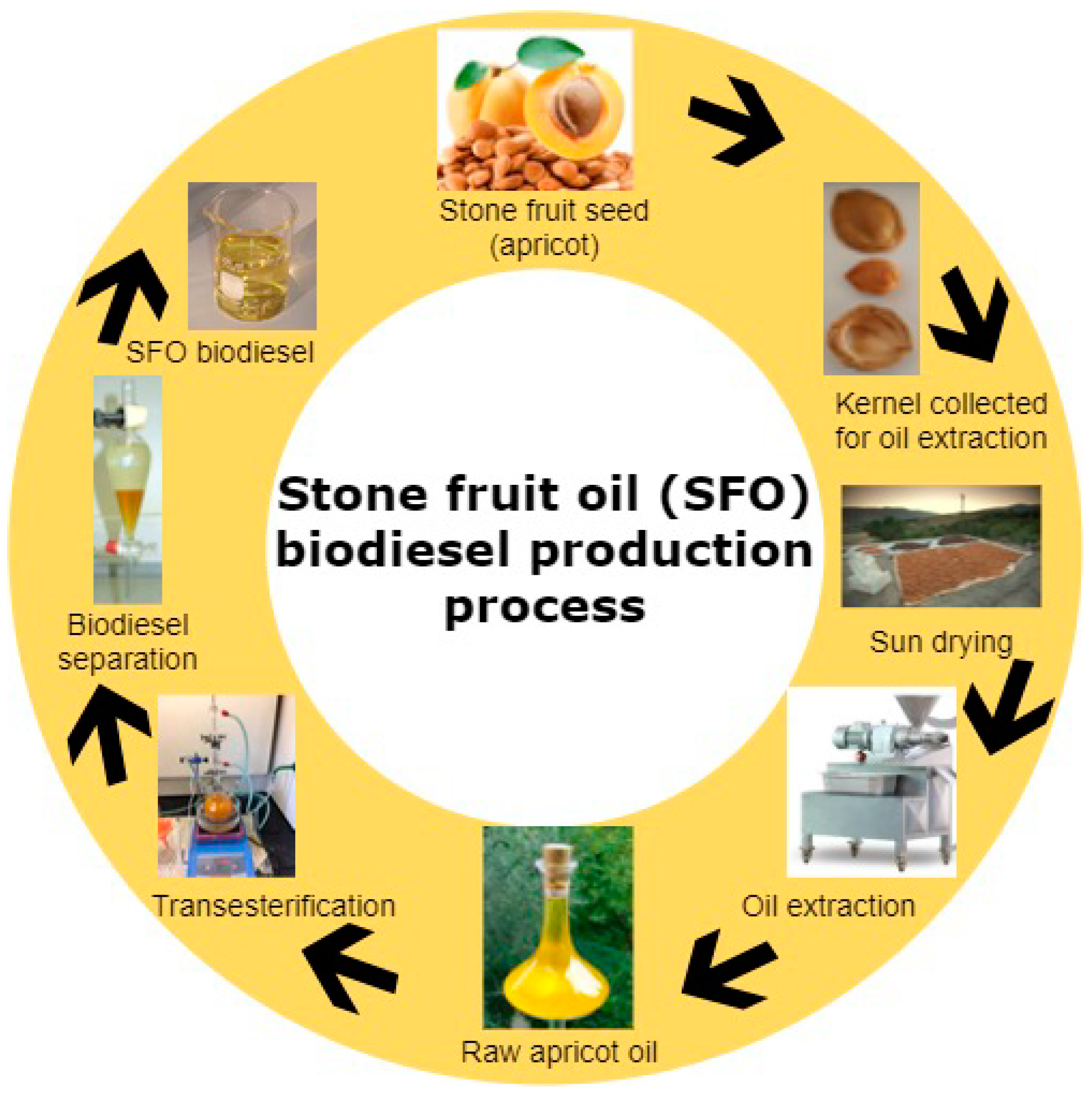
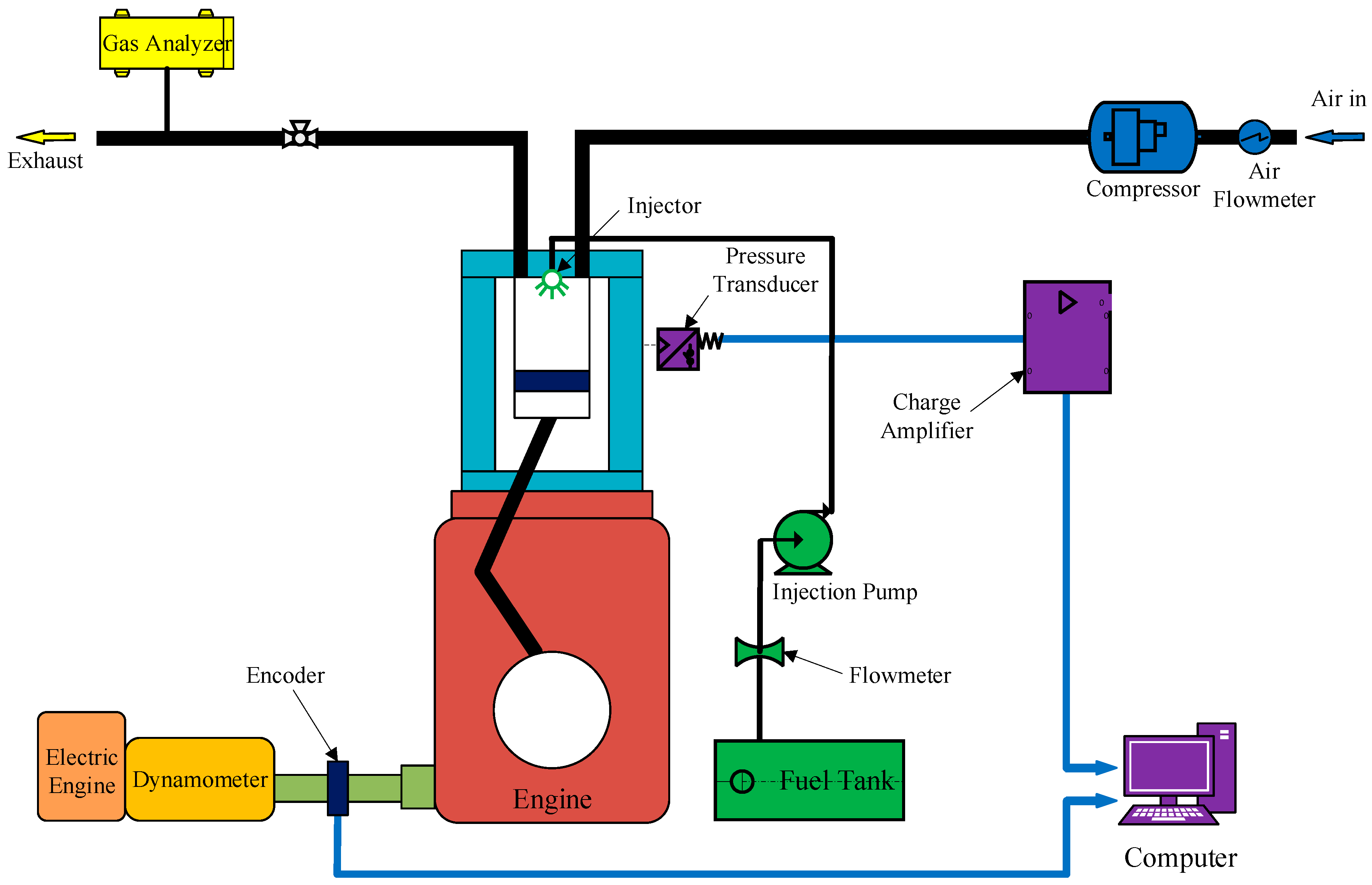
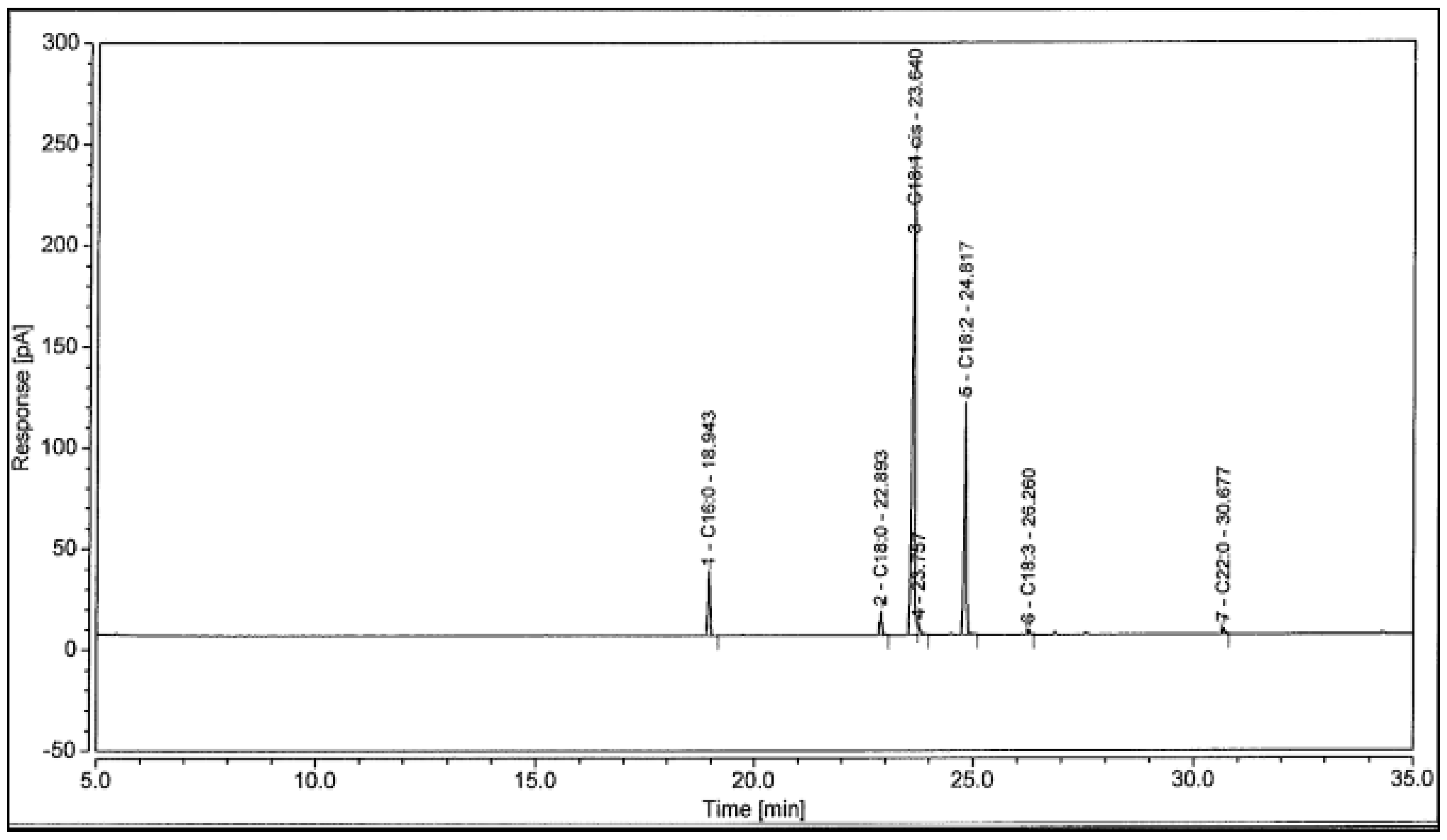
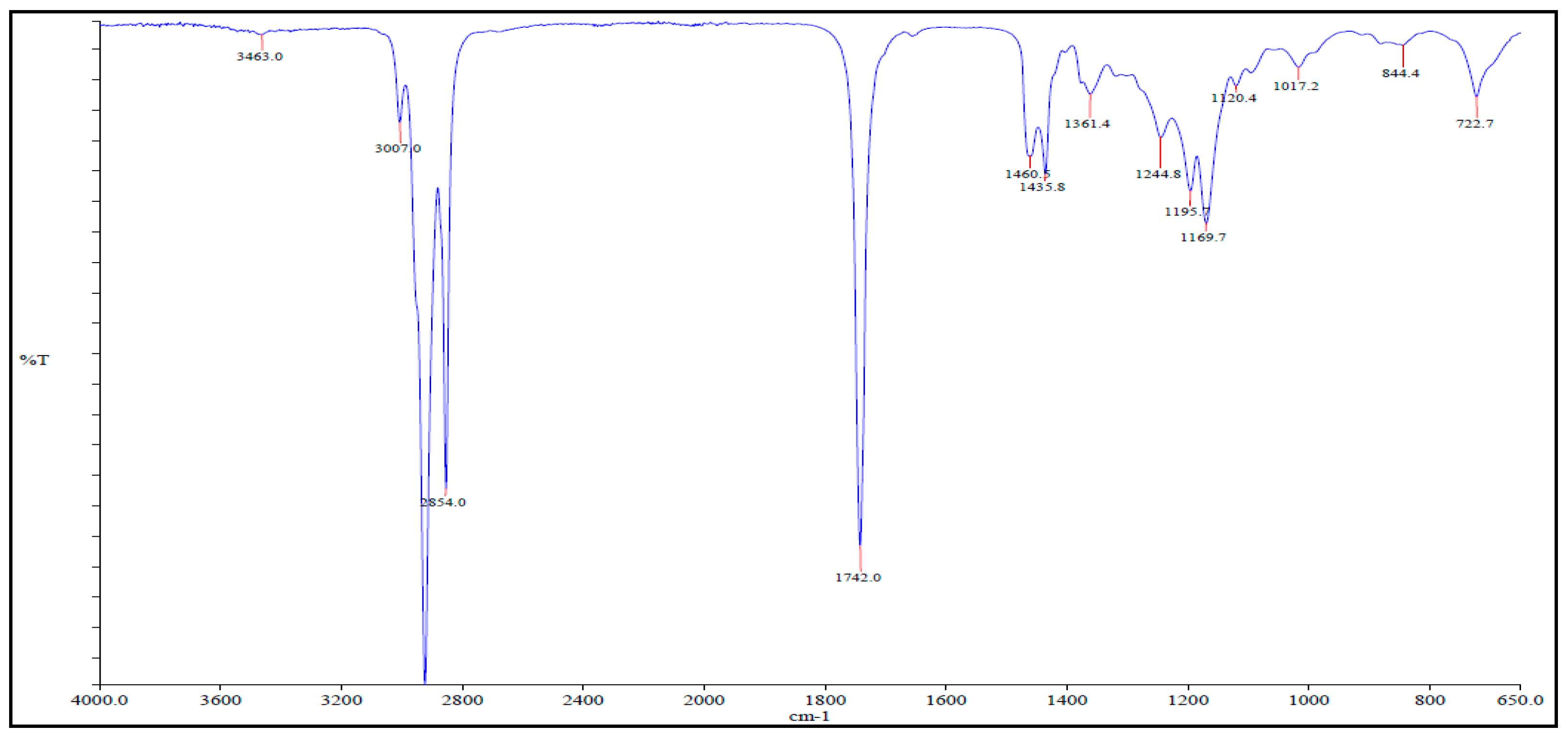
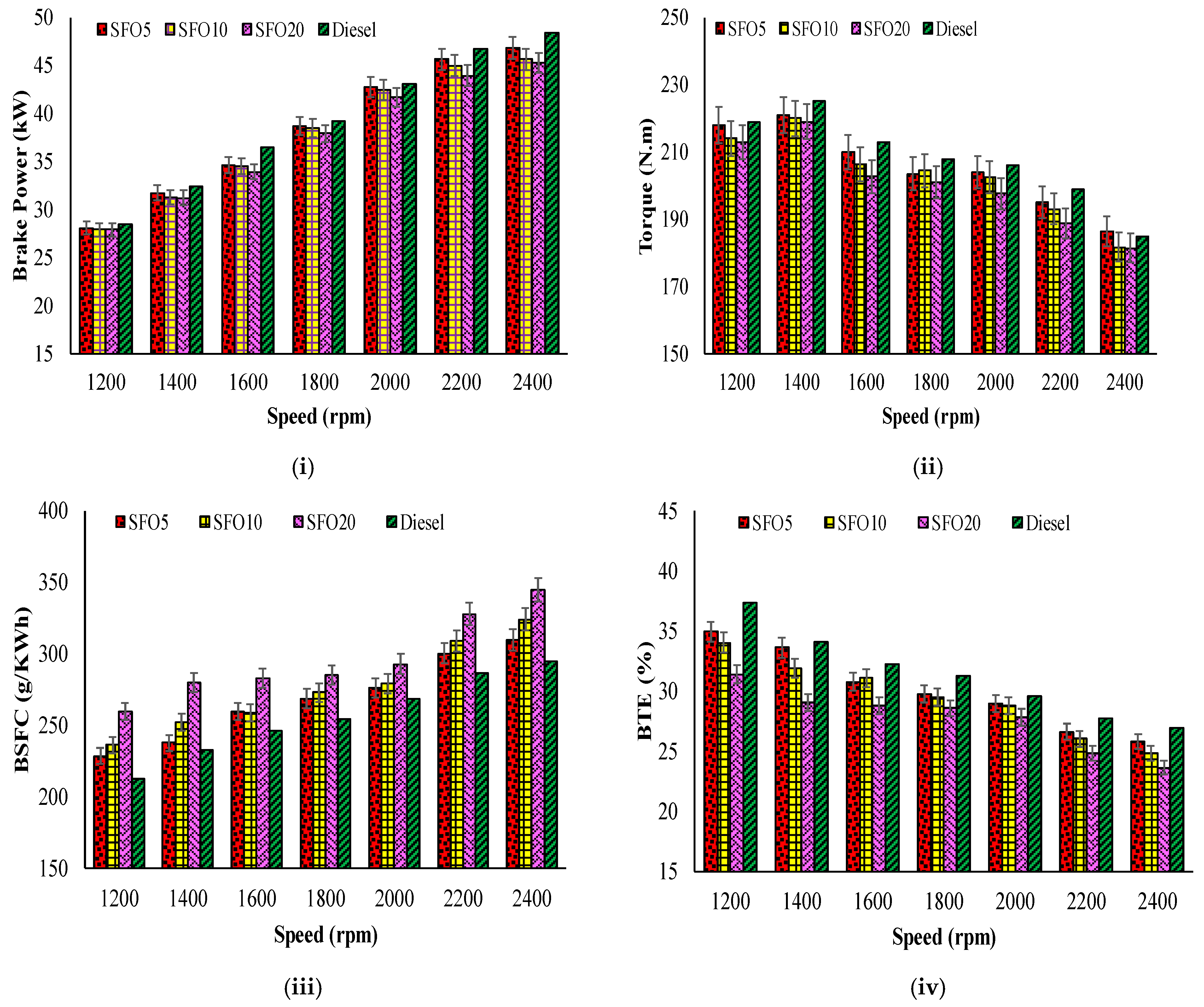

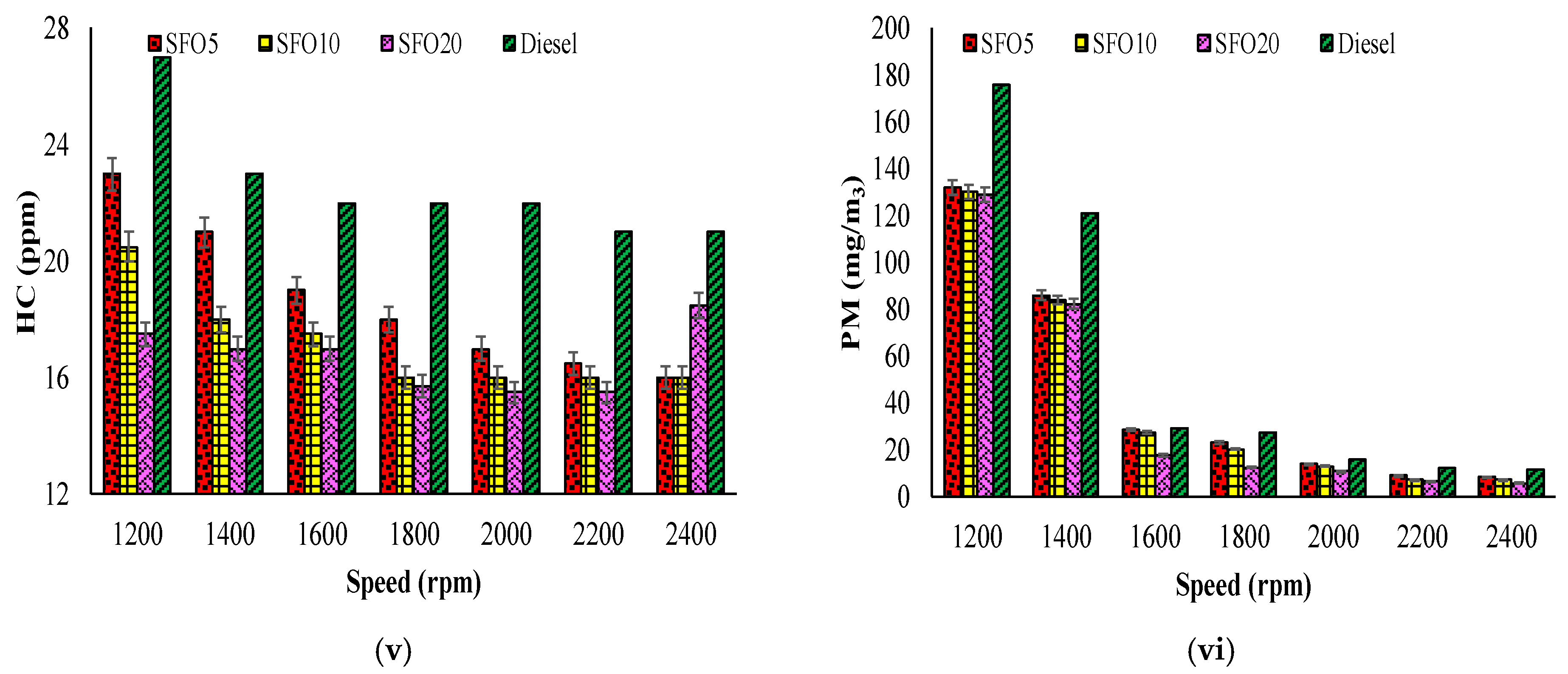


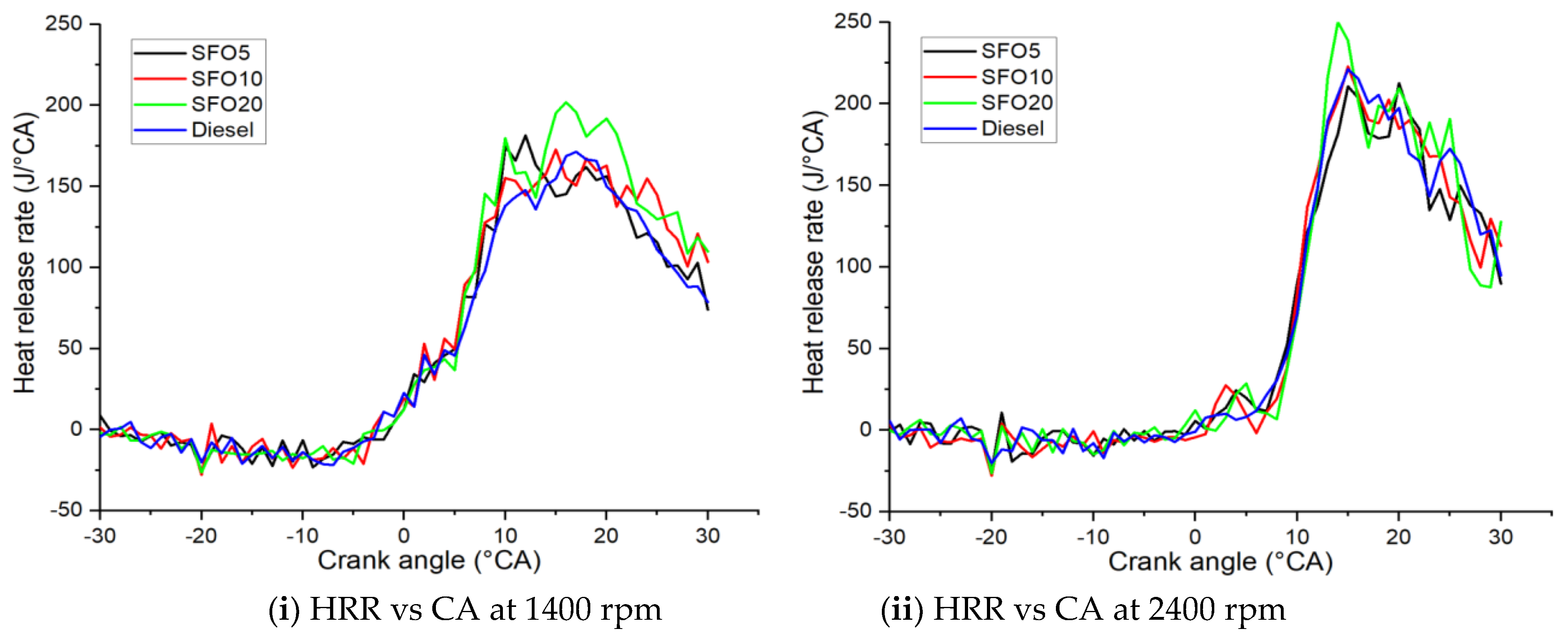


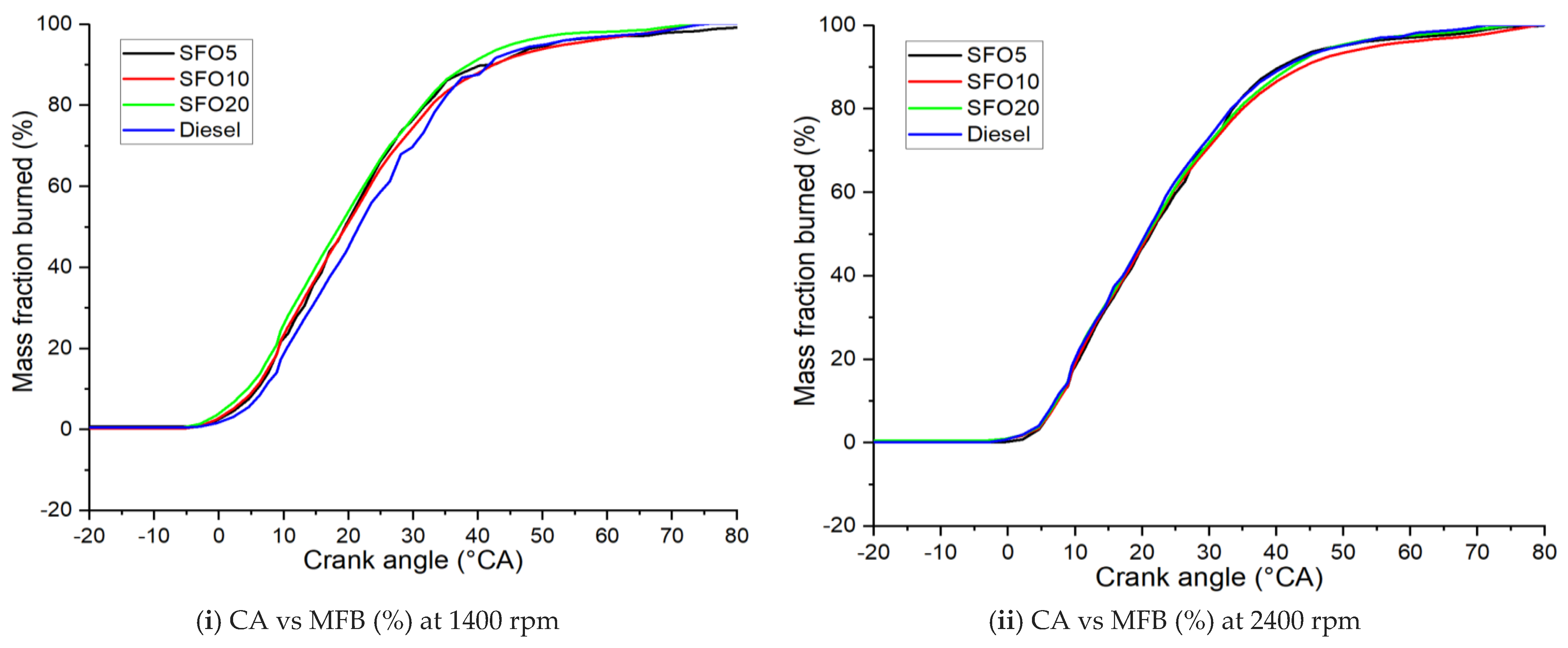
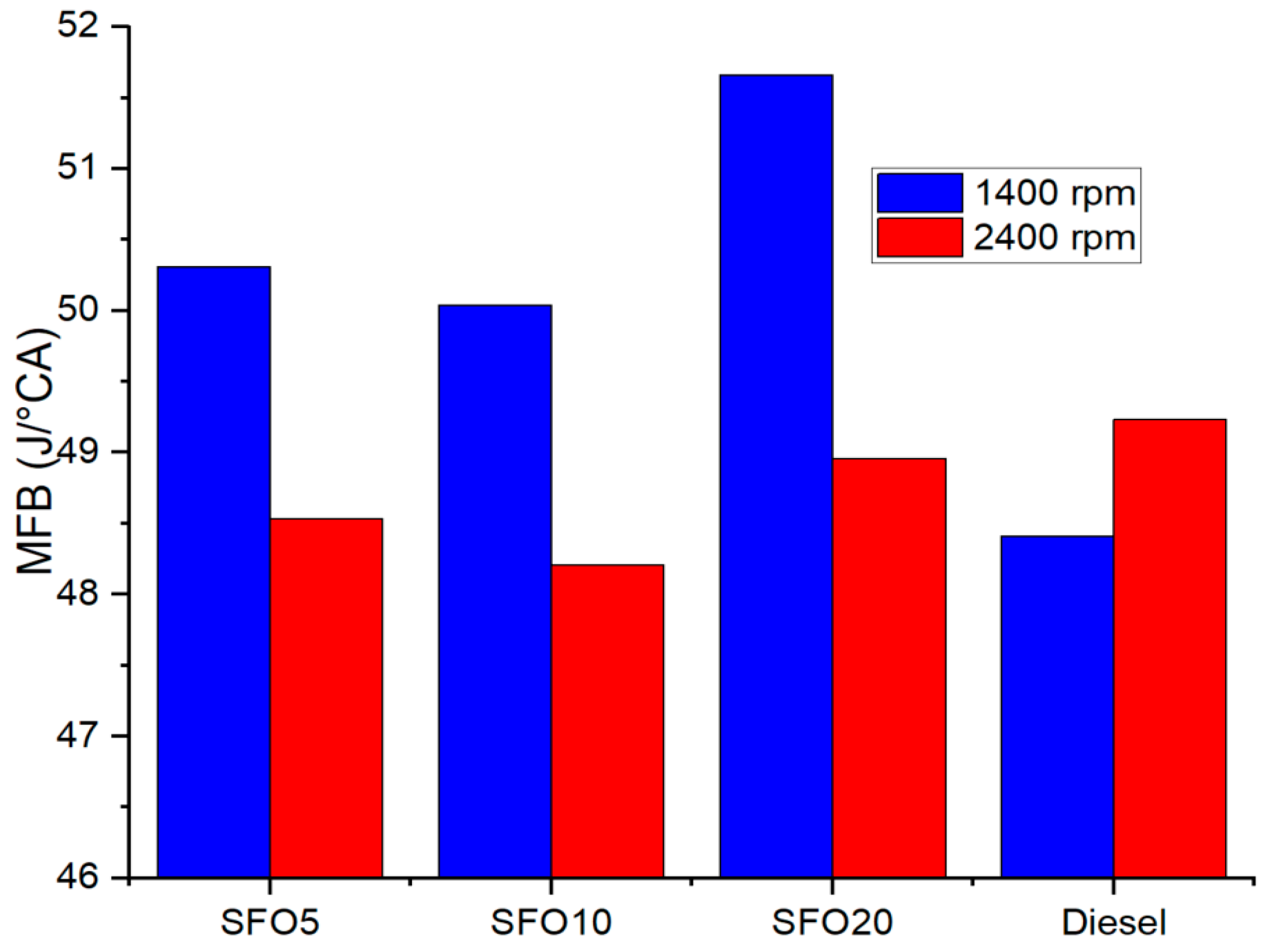
| Properties | ASTM Standard | Measuring Tool |
|---|---|---|
| Calorific value | D240 | 6100EF semi-auto bomb calorimeter |
| Kinematic viscosity | D445 | NVB classic |
| Density | D1298 | DM40 LiquiPhysicsTM |
| Acid value | D664 | Automation titration Rondo20 |
| Flash point | D93 | NPM 440 Pensky-Martens |
| Oxidation stability | D2274 | 873 Rancimat |
| Items | Specifications |
|---|---|
| Model | Kubota V3300 |
| Type | Vertical, 4 cycle liquid cooled diesel |
| No. of cylinders | 4 |
| Total displacement (m3) | 3318 |
| Bore × Stroke (mm) | 98 × 110 |
| Combustion type | Spherical type [E-TVCS (Three vortex combustion system)] |
| Intake system | Naturally aspirated |
| Rated power output (kW.rpm−1) | 53.90/2600 |
| Rated torque (Nm.rpm−1) | 230/1400 |
| Compression ratio | 22.60:1 |
| Fuel injection timing | 16° before top dead centre (TDC) |
| Injection pressure (MPa) | 13.73 |
| Emissions certification | Tier 2 |
| Measuring Parameter | Range | Accuracy |
|---|---|---|
| Engine load | 0–15 kg | ±0.01 kg |
| Engine speed | 0 rpm to 3000 rpm | ±5 rpm |
| Crank angle | 0–360° | ±1° |
| Temperature | 1–2000 °C | ±1 °C |
| Pressure | 0.5–100 bar | ±0.01 bar |
| Air flow rate | 16.00–32.00 kg·hr−1 | ±0.01 kg·hr−1 |
| Fuel flow rate | 0.1–1.5 kg·hr−1 | ±0.01 kg·hr−1 |
| NOx | 0–5000 ppm | ±1.0 ppm |
| HC | 0–30000 ppm | ±1.0 ppm |
| CO | 0–15% | ±0.02% |
| CO2 | 0–20% | ±0.30% |
| PM | <100 nm to >10 μm | ±0.10 nm |
| Calculated Parameter | Range | Uncertainty |
| Brake power (BP) | - | 0.90% |
| Torque | - | 0.90% |
| Brake specific fuel consumption (BSFC) | - | 1.15% |
| Brake thermal efficiency (BTE) | - | 1.15% |
| Fuels | Density (kg·m−3) | Viscosity at 40 °C, mm2·s−1 | Acid Value, mg KOH·g−1 | Cetane Number (CN) | Calorific Value, MJ·Kg−1 | Flash Point, °C | Iodine Value (IV) mgl2·100 g−1 | Oxidation Stability (OS), h |
|---|---|---|---|---|---|---|---|---|
| SFO | 855.0 | 4.26 | 0.25 | 50.45 | 39.64 | 105 | 104.70 | 7.15 |
| SFO5 | 827.2 | 3.28 | 0.06 | 48.12 | 45.02 | 70.33 | 41.62 | 37.41 |
| SFO10 | 829.9 | 3.33 | 0.07 | 48.25 | 44.73 | 72.15 | 44.94 | 35.82 |
| SFO20 | 832.7 | 3.44 | 0.09 | 48.49 | 44.17 | 75.80 | 51.58 | 32.63 |
| Ref. diesel | 827.2 | 3.23 | 0.05 | 48.00 | 45.30 | 68.5 | 38.3 | 39.0 |
| ASTM D6751 | 880.0 | 1.9~6.0 | max. 0.5 | min. 47 | - | 100~170 | - | min. 3 |
| EN14214 | 860~ or ~900 | 3.5~5.0 | max. 0.5 | min. 51 | 35 | min. 101 | max. 120 | min. 6 |
| AU Standard | 860~ or ~890 | 3.5~5.0 | max. 0.8 | min. 51 | - | min. 120 | max. 120 | min. 6 |
| Fatty Acids | Formula | Molecular Weight | Structure | wt% |
|---|---|---|---|---|
| Palmitic | C16H32O2 | 256 | 16:0 | 5.85 |
| Stearic | C18H36O2 | 284 | 18:0 | 2.51 |
| Oleic | C18H34O2 | 282 | 18:1 | 63.8 |
| Linoleic | C18H32O2 | 280 | 18:2 | 25.3 |
| Linolenic | C18H30O2 | 278 | 18:3 | 0.51 |
| Behenic | C22H44O2 | 340 | 22:0 | 0.66 |
| Others | 1.29 | |||
| Total Saturated Fatty Acids (SFA) | 9.02 | |||
| Total Monounsaturated Fatty Acids (MUFA) | 63.84 | |||
| Total Polyunsaturated Fatty Acids (PUFA) | 25.85 | |||
| The Degree of Unsaturation (DU) | 115.5 | |||
| Long Chain Saturated Factor (LCSF) | 2.83 | |||
Publisher’s Note: MDPI stays neutral with regard to jurisdictional claims in published maps and institutional affiliations. |
© 2022 by the authors. Licensee MDPI, Basel, Switzerland. This article is an open access article distributed under the terms and conditions of the Creative Commons Attribution (CC BY) license (https://creativecommons.org/licenses/by/4.0/).
Share and Cite
Anwar, M.; Rasul, M.G.; Hassan, N.M.S.; Jahirul, M.I.; Haque, R.; Hasan, M.M.; Mustayen, A.G.M.B.; Karami, R.; Schaller, D. Stone Fruit Seed: A Source of Renewable Fuel for Transport. Energies 2022, 15, 4667. https://doi.org/10.3390/en15134667
Anwar M, Rasul MG, Hassan NMS, Jahirul MI, Haque R, Hasan MM, Mustayen AGMB, Karami R, Schaller D. Stone Fruit Seed: A Source of Renewable Fuel for Transport. Energies. 2022; 15(13):4667. https://doi.org/10.3390/en15134667
Chicago/Turabian StyleAnwar, M., M. G. Rasul, N. M. S. Hassan, M. I. Jahirul, Rezwanul Haque, M. M. Hasan, A. G. M. B. Mustayen, R. Karami, and D. Schaller. 2022. "Stone Fruit Seed: A Source of Renewable Fuel for Transport" Energies 15, no. 13: 4667. https://doi.org/10.3390/en15134667
APA StyleAnwar, M., Rasul, M. G., Hassan, N. M. S., Jahirul, M. I., Haque, R., Hasan, M. M., Mustayen, A. G. M. B., Karami, R., & Schaller, D. (2022). Stone Fruit Seed: A Source of Renewable Fuel for Transport. Energies, 15(13), 4667. https://doi.org/10.3390/en15134667









